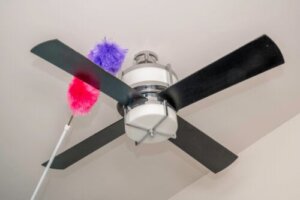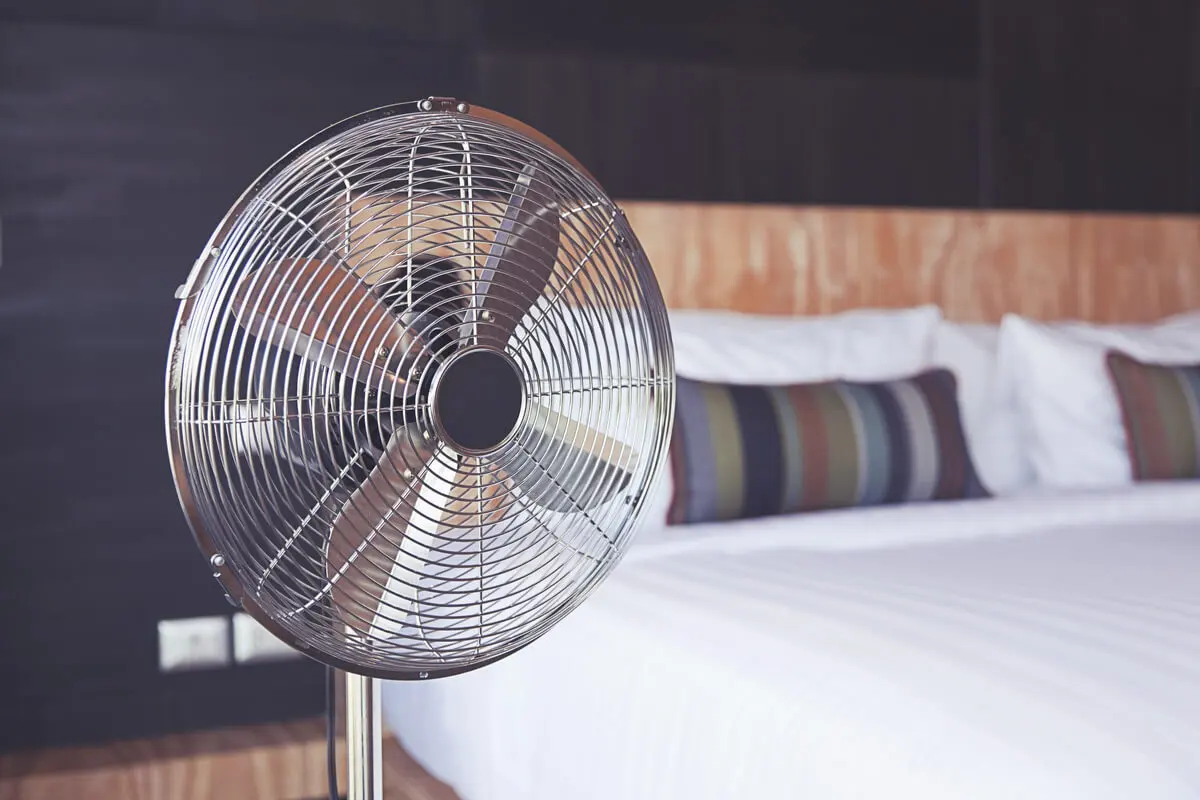4 Steps to Clean Ceiling Fans

Once the spring months are over and the extreme heat gives way to the arrival of autumn, certain objects are no longer used. This is especially the case for those that are responsible for cooling rooms, such as air conditioners and fans. For efficient maintenance, it’s important to follow these steps to clean ceiling fans.
Dust, dirt, and grease often accumulate on the blades. For floor fans, the cleaning is similar, but easier.
Cleaning ceiling fans involve the hassle of climbing a ladder and turning off the electrical connection. Whether it’s to prepare them for winter or to use them as heat removers, the following tips are essential to do this.
Why follow certain steps to clean ceiling fans?
During the summer months, ceiling fans work constantly to cool and generate a breeze in the environment. Even with air conditioning, these appliances are useful for removing and distributing cool air throughout the room. For this reason, it’s common for them to accumulate dust, dirt, and pollen on the blades and motor.
In addition, if they’re installed in spaces such as the kitchen, it’s also possible for grease to accumulate in the appliance. To remove all the dirt and promote maintenance, it’s important to follow a series of steps to clean ceiling fans.
The end of summer presents itself as an ideal time for this task.
Remember to clean them whenever necessary
Many people use the fans also during the winter, due to the function that some devices have to reverse the rotation of the blades. With this measure, it’s possible to remove the hot air from the heaters that usually accumulate in the upper part of the room.
Therefore, the cleaning of the appliances is essential both in the summer and in winter. In this way, maintenance that favors optimal operation throughout the year is achieved. In addition, electricity consumption is optimized, since accumulated dirt makes the motor work more and consume more energy.

We think you may be interested in reading this, too: The 7 Most Difficult Corners to Clean: How To Clean Them
Tools to use
To achieve efficient cleaning of the appliance, it’s a good idea to have a set of basic tools and supplies. This is a simple task, but it requires precise and careful work as far as electricity is concerned.
- Soap and water are very necessary elements for cleaning glass bulbs.
- A pillowcase: Its texture is ideal for gently removing dust from the blades.
- A ladder: Ceiling fans are usually at considerable heights. Therefore, a ladder is ideal for reaching a comfortable position during cleaning.
- Multi-purpose cleaning products: These may include a degreasing component that works to remove grime from the fan.
- A vinegar and water solution: This can be used as an alternative to the all-purpose cleaner.
- A microfiber cloth: Like the pillowcase, this is an ideal texture for this cleaning routine.
- Compressed air: If you have this, it’s useful for removing dust that accumulates inside the motor.
4 steps to clean ceiling fans
Cleaning these appliances is a simple task, but is also essential to ensure their optimal operation, durability, and total cleanliness of the room. A fan with dirty blades can distribute dust particles throughout the room. The following steps can keep the object clean, preventing dirt from falling on furniture and floors.
1. Dust the blades
The first step to leaving a ceiling fan sparkling clean is to remove the dirt from the blades. To do this, pull up a ladder and place it under the unit so that when you climb up, you’re in a comfortable and safe position to clean. Make sure the fan is turned off and the electrical connection is inactive.
Once in position, take the pillowcase and spray it with the cleaner or vinegar and water. Gently glide over each blade, trying to remove as much grime as possible. When finished, wipe the edges with a microfiber cloth to remove any remaining dirt.
2. Clean the light bulbs and glass globes
For this particular step, it’s essential that the electrical connection is turned off. This involves cleaning the bulbs and all the parts that generate light.
Gently wipe each one with a microfiber cloth. It’s important that the cloth is dry.
If the fixture has glass bulbs, remove and wash them with soap and water. Make sure they’re completely dry before reinstalling them.
3. Clean the motor
The motor can be effectively cleaned by wiping it with a microfiber cloth. Go over it with a dry cloth and include the drive chain.
If a compressed air cleaner is available, use it to remove dirt from the inside of the motor. Replace all components and adjust as necessary.

4. Use lubricating oil
Some devices require the application of lubricating fluid as a final cleaning step. This prevents it from producing annoying noises over time as it operates. In general, the hole for inserting the oil is located on the top of the motor.
However, the manufacturer’s manual should be checked to locate the precise location and amount of lubricant required for that appliance. Once the liquid has been deposited, push the blades gently. In this way, the oil is distributed throughout the motor.
Like this article? You may also like to read: 10 Reasons Why Your House Looks Dirty Even if You Clean It Daily
How often should you repeat these steps to clean ceiling fans?
In the event that the fan is also used during the cold months to distribute warm air, it’s advisable to clean it every 2 or 3 months. This is a frequency according to the time it generally takes for dirt to accumulate on the blades. If it’s noticeable that a layer of dust has already formed before 2 months, then you should clean it sooner.
The important thing is to prevent particles from falling into the environment while the fan is in operation. Depending on the room and the amount of dust circulating in the home, this cleaning routine can be performed more or less frequently.
All cited sources were thoroughly reviewed by our team to ensure their quality, reliability, currency, and validity. The bibliography of this article was considered reliable and of academic or scientific accuracy.
- Reinoso Sánchez, Miguel, Buchelli Carpio, Luis, Disminución de contaminantes aéreos en una planta de balanceados mediante la propuesta de un sistema de extracción de polvo. Ingenius. Revista de Ciencia y Tecnología [Internet]. 2014; (12):5-14. Recuperado de: https://www.redalyc.org/articulo.oa?id=505554818002
- Enerdata. “Consumo Energético Mundial | Consumo Eléctrico | Enerdata.” Enerdata. N.p., 2020. Disponible en: https://datos.enerdata.net/electricidad/datos-consumo-electricidad-hogar.html
- Estaba, Richard, Collado, María, Suárez, Diógenes, Rodríguez, Edgar, Estudio de los factores que producen disminución en la eficiencia de los ventiladores utilizados en las cabinas de pinturas presurizadas. Ciencia e Ingeniería [Internet]. 2006;28(1):33-36. Recuperado de: https://www.redalyc.org/articulo.oa?id=507551355006
- Rodríguez Magaña, José Rafael, Rebollar Rebollar, Samuel , Hernández Martínez, Juvencio, Guzmán Soria, Eugenio, Consumo de energía eléctrica para uso doméstico en San Juan del Río, Querétaro. Análisis Económico [Internet]. 2011;XXVI(61):139-151. Recuperado de: https://www.redalyc.org/articulo.oa?id=41318401009
This text is provided for informational purposes only and does not replace consultation with a professional. If in doubt, consult your specialist.








